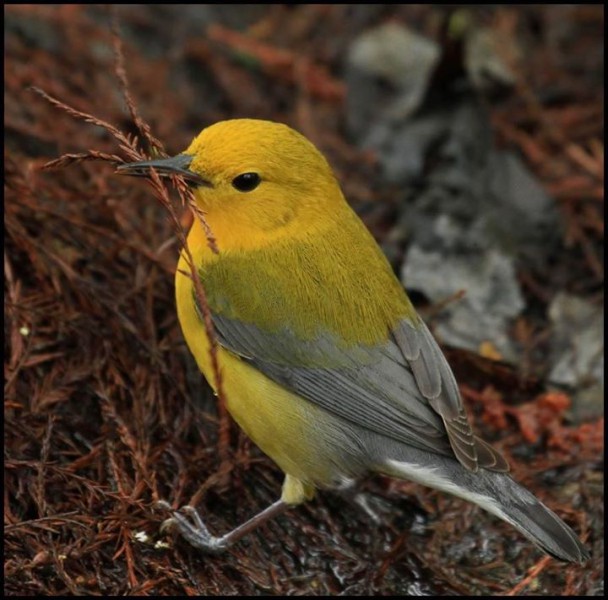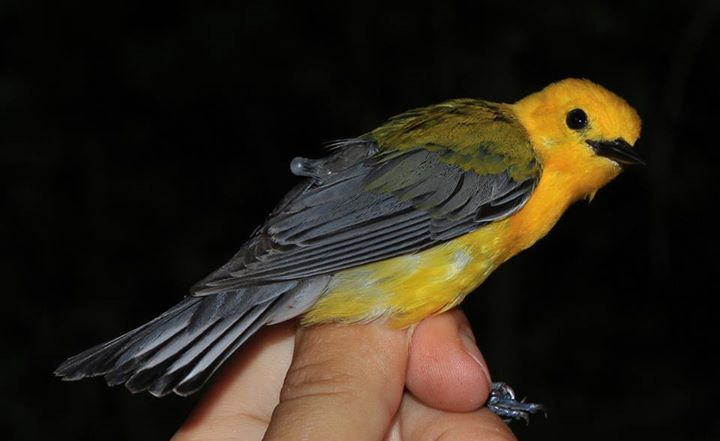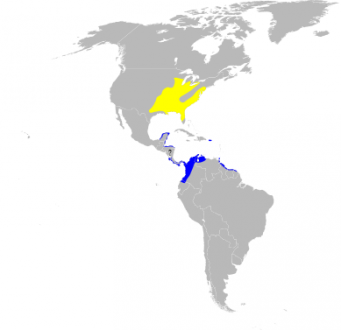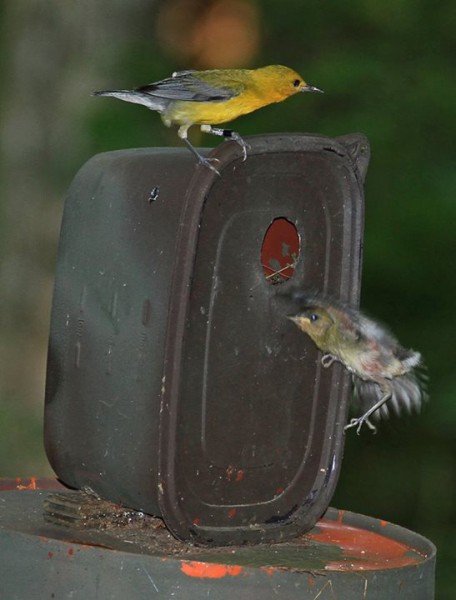- Geolocator tags have become small enough to be used on tiny birds, such as the prothonotary warbler.
- Researchers now know far more about warbler migration routes, which will facilitate conservation plans for this species.
- An initial warbler study showed that the small birds winter in northern Colombia, where their preferred habitat is currently under threat from human activity.
For decades, researchers have been trying to piece together the secret lives of songbirds. One such bird is the prothonotary warbler (Protonotaria citrea). Known for its bright yellow color, this species (thought to be named for its color resemblance to the cloaks worn by prothonotaries, high-ranking Catholic scribes) spends spring and summer in swampy areas as far north as southern Michigan and as far west as eastern Texas, migrating south for the winter. Until recently, this migrant had flown under the radar during the winter months; no one knew to where, exactly, they migrated.

Jared Wolfe, founder of the Louisiana Bird Observatory, and his colleague Erik Johnson, director of Bird Conservation at the Louisiana Audubon Society, with the help of volunteers from the Prothonotary Warbler Working Group, equipped 47 warblers with 0.5-gram geolocator backpack-type tags in 2014. In an interview with WildTech, Wolfe explained that the migration study ended this year when researchers recaptured 15 of the original birds. The data collected from these 15 birds have not yet been processed; however, Wolfe and his colleagues did find “negligible differences” of return rates of birds with and without the tiny tags, meaning that the tags did not appear to affect flight movement. The geolocators on the birds that were not recaptured are designed to degrade over a year or less, with a cord made of “stretch magic,”- a plastic resin subject to degradation- and will eventually fall off. The effectiveness of the degradation likely depends on where the birds spend the majority of their time, says Wolfe- sun and salt catalyze the degradation process.

In 2013, Wolfe and Johnson tagged three prothonotary warblers in a feasibility study to determine whether the birds would return to the same site after their migration and whether the tags would stay on the warblers throughout the entire migration until recapture. But one young bird did not return to the study area, and a second bird managed to escape from his geolocator tag before leaving the study site, according to Wolfe. The third time was the charm, though; a bird named GeoDad held on to his geolocator and returned faithfully to the study site. Upon GeoDad’s return, Wolfe, Johnson and their colleagues downloaded the tag’s data to understand his migratory pattern and where in the world he flew for winter. It turns out that GeoDad flew about 5,000 miles roundtrip and wintered in sunny northern Colombia- home to swampy wetlands that are under threat by fragmentation, colonization, mining, logging, and, more recently, hydropower expansion.

Wolfe tracked GeoDad’s movements with light-level geolocator tags. The tags – first used by Bridget Stutchbury, a biology professor at York University in the UK, and her colleagues at Purple Martin Conservation Association and the Natural Environment Research Council – log the duration of daylight and the time of sunrise and sunset to track an animal’s location. Stutchbury and her colleagues conducted the first study using light-level geolocator tags on songbirds in 2007. They tracked the migration of 14 wood thrushes (Hylocichla mustelina) and 20 purple martins (Progne subis) for a year and analyzed the sunrise and sunset times to determine their routes and wintering locations. The “smaller-than-dimes” geolocators the researchers used were developed by the British Antarctic Survey and weighed 1.6 grams, about one gram heavier than the tags used in the 2013 warbler study—albeit used with larger subjects.
Light-level geolocators use a tiny computer, memory, and an internal clock to measure the hours of sunlight and are programmed to record sunrise and sunset times. The data are then analyzed, in this case on the BASTrack software system, to determine the longitude and latitude of the bird over time.
Challenges of using geolocator tags include determining whether the target species display “site fidelity,” that is, whether they return to the same breeding grounds every year. This is important when using small tags that do not offload location data and must be recovered. Using species that can be regularly and easily monitored helps, says Wolfe.
In addition, the geolocator estimates are prone to errors (e.g. ~150 km), with the uncertainty caused mainly by possible attenuation of the ambient light level, e.g. from clouds, feathers, foliage, steep hills, at any given time. Thus, the tags should not be used in studies that require more precision than the general migration route that a study is observing or for species roosting at dawn and dusk in thick foliage.
Nevertheless, geolocator tags are an affordable and effective method to find general connectivity, prolonged stop-over behavior and certain species’ secondary wintering areas, the “additional locations that provision food and shelter, where migrant birds spend considerable amounts of time” (Wolfe, personal communication 2015). Small tags with no offload use very little power and can last up to several years, and some tags collect ambient temperature data, which improve the location accuracy.

Detailing the migratory routes of these songbirds will enhance the species’ chances of survival. Threats such as logging activity and climate change can negatively affect their highly specific preferred habitat. Now that researchers understand where the birds’ swampy, non-breeding habitats are, it is easier to pinpoint conservation strategies and manage protected areas to ensure habitat and food security.
The geolocator tag study was so successful that another project is now underway, this time with collaborators from Ohio State University and Arkansas State University. For this, the researchers have tagged 30 warblers and sent them on their way. Given sufficient resources, these and future studies will help the conservation community craft an international conservation plan for this species.
Wolfe told Wildtech that researchers interested in conducting similar studies should “Consider a pilot study, ideally with dummy tags, to make sure the birds return in sufficient enough numbers to warrant the [full] study.” Although next generation GPS tags may soon replace light-level geolocators for some taxa, the new GPS units are still too heavy for small birds. After all, a few grams can be quite a burden when you weigh 14 grams yourself and you’re flying halfway around the world.
Have you used geolocator tags like these for small species? Share your experiences with these devices in the forum!